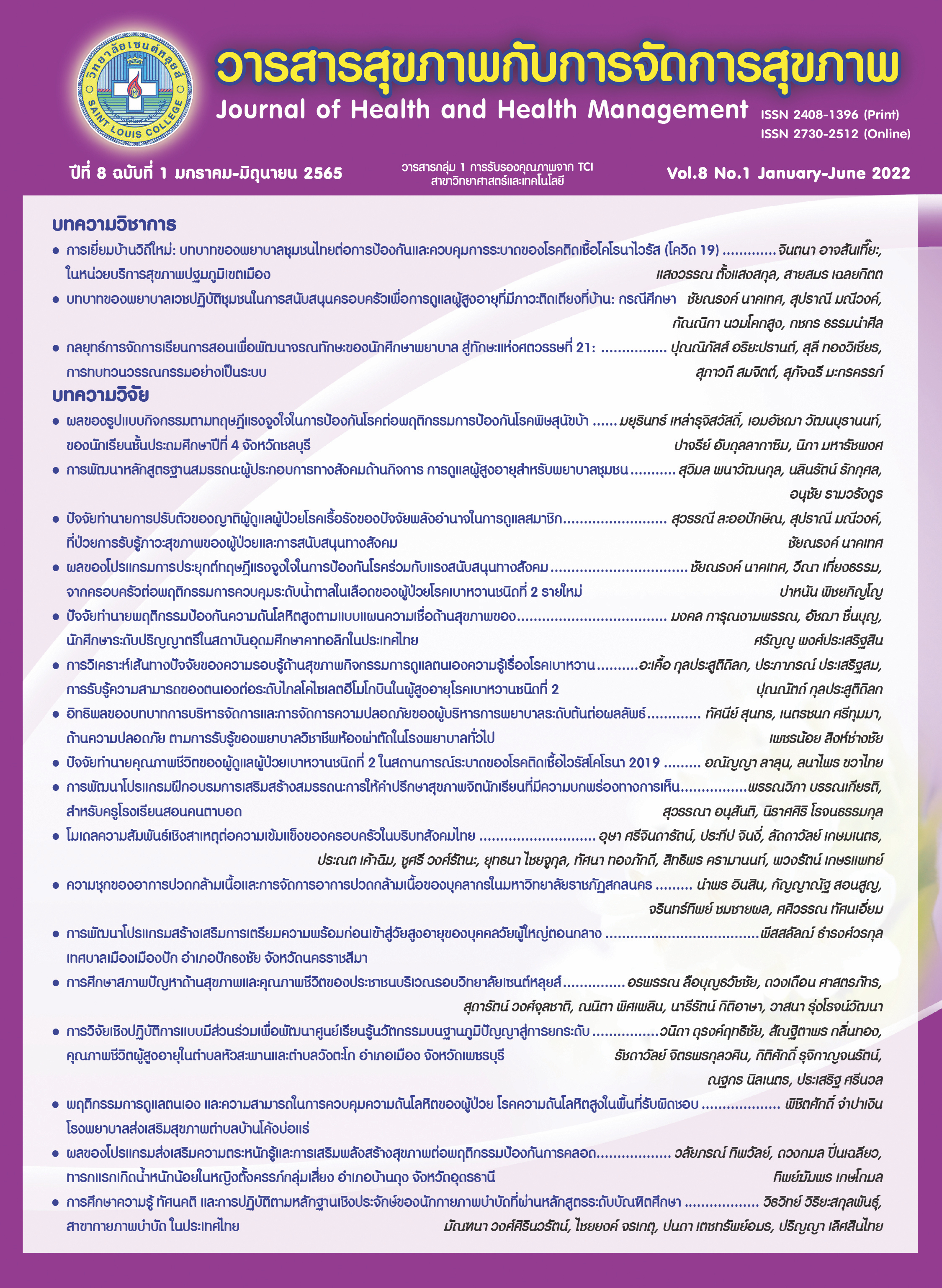The Role of Community Nurse Practitioners in Supporting Families in Caring for Bedridden Elders at Home: Case Study
Keywords:
Bedridden elderly, Home care, Supporting FamilyAbstract
The number of elderly people in Thailand is increasing. Most of them suffer from chronic diseases that possibly cause deterioration and disability of their health conditions. These complications eventually lead the elderly patients to become bedridden. Bedridden elderly patients are usually cared for specially by their family members that are close to home. Unfortunately, some of the family members of these elderly population, may not fully care for them because of their other responsibilities such as working, travelling from a distance, or even their own health issues. This places a toll on the care of the bedridden elderly patients. Apart from that, the bedridden clderly often require total or partial assistance with their activities daily livings, and in many case, they also have other specific and complicated needs that may arise during the course of their care. For these reasons, their family members seek competent and qualified elderly caregivers or elderly care centers to take care of their bedridden seniors. Additionally, it is challenging for community nurse practitioners to support these families and their bedridden elderly patients at home due to the constraints associated with their health care and needs.
The purpose of this paper is to present the role and responsibilities of the community nurse practitioners through the application of Orem’s nursing system theory in supporting effective home care for the bedridden elderly. The emphasis is placed on families and caregivers to learn and consider making decisions and to practice caring for the bedridden elderly at home efficiently and sustainably. This will not only allow the elderly patients to be with their own family, but will also increase their chances of staying healthy and having a good quality of life.
References
จินตพักตร์ จันทะโคตร, ทัศนีย์ รวิวรกุล, พัชราพรเกิดมงคล, และพิชัย จันทร์ศรีวงศ์. (2564). ผลของโปรแกรมการพยาบสนับสนุนและให้ความรู้สำหรับญาติผู้ดูแลผู้สูงอายุที่ได้รับเคมีบำบัดแบบผู้ป่วยนอก. วารสารการพยาบาลและการศึกษา, 14(2),11-24.
จุฬาวรี ชัยวงค์นาคพันธ์, ศิริกาญจน์ จินาวิน, วราภรณ์ ยศทวี, กชพร พงษ์แต้, และเจษฎาภรณ์ อิกำเหนิด.(2561). บทบาทของพยาบาลในการพัฒนาความสามารถและลดความเครียดของผู้ดูแลผู้ป่วยที่มีปัญหาในระบบประสาท. วารสารวิทยาลัยพยาบาลบรมราชชนนี อุตรดิตถ์, (ฉบับพิเศษ),151-162.
ดุษฎี ไตรยวงศ์, สุนีย์ ละกำปั่น และทัศนีย์ รวิวรกุล.(2563). ผลของโปรแกรมการพยาบาลแบบสนับสนุนและให้ความรู้ต่อความสามารถในการดูแลผู้ป่วยโรคหลอดเลือดสมองที่บ้านของผู้ดูแล.วารสารศูนย์การศึกษาแพทยศาสตร์คลินิก โรงพยาบาลพระปกเกล้า, 37(3), 240-249.
นงลักษณ์ พะไกยะ, ศิริพันธุ์ สาสัตย์ และวาสินี วิเศษฤทธิ์.(2564). ความต้องการกำลังคนด้านสุขภาพเพื่อรองรับผู้สูงอายุที่มีภาวะพึ่งพิงในอนาคต. วารสารวิจัยระบบสาธารณสุข. 15(2), 200-217.
ปาหนัน พิชยภิญโญ, ปัญญรัตน์ ลาภวงศ์วัฒนา, พัชราพรเกิดมงคล และอาภาพร เผ่าวัฒนา. (2556).ทฤษฎีการพยาบาลและการประยุกต์: บุคคล ครอบครัวและชุมชน. กรุงเทพฯ: แดเน็กซ์อินเตอร์คอร์ปอเรชั่น.
พารุณี วงษ์ศรี และทีปทัศน์ ชินตาปัญญากุล. (2561).การประยุกต์ใช้ทฤษฎีของโอเร็มกับการดูแลและการให้คำแนะนำผู้ป่วยที่มีภาวะหัวใจล้มเหลว.วารสารพยาบาลตำรวจ, 10(1), 209 -219.
พิมพ์ลักษณ์ รังษีภโนดร, ชัชวาล วงค์สารี, และอัมพรเจียงวิริชัยกูร. (2561). การประยุกต์ใช้ทฤษฎีการดูแลตนเองของโอเร็มในการดูแลป้องกันการเกิดแผลที่เท้าของผู้ป่วยโรคเบาหวาน. วารสารวิชาการมหาวิทยาลัยอีสเทิร์นเอเชีย, 12(3), 89-100.
มูลนิธิสถาบันวิจัยและพัฒนาผู้สูงอายุไทย (มส.ผส.).(2564).สถานการณ์ผู้สูงอายุไทย พ.ศ. 2563.นครปฐม: สถาบันวิจัยประชากรและสังคมมหาวิทยาลัยมหิดล.
วารุณี มีเจริญ. (2557). ญาติผู้ดูแลผู้ป่วยมะเร็ง: การปรับตัวต่อบทบาทและการส่งเสริมคุณภาพชีวิต.Rama Nurse J, 20(1), 10-22.
ศิริพร เสมสาร, สุชิรา ชัยวิบูลย์ธรรม, และพิชัย จันทร์ศรีวงศ์. (2561). ผลของโปรแกรมส่งเสริมความสามารถของญาติผู้ดูแลต่อผลลัพธ์ด้านญาติผู้ดูแลและด้านผู้ป่วยในการดูแลผู้ป่วยเรื้อรังระยะท้าย. วารสารการปฏิบัติการพยาบาลและการผดุงครรภ์ไทย, 5(1), 112-116.
สภาการพยาบาล. (2552). ประกาศสภาการพยาบาล.ขอบเขตและสมรรถนะการปฏิบัติการพยาบาลขั้นสูงสาขาการพยาบาลเวชปฏิบัติชุมชน. สืบค้นเมื่อวันที่ 25 ตุลาคม 2564, จาก https://www.tnmc.or.th/images/userfiles/files/H014.pdf
สภาการพยาบาล. (2564). ประกาศสภาการพยาบาล.แนวทางการพยาบาลทางไกล (Tele-nursing). สืบค้น จาก: https://www.tnmc.or.th/images/userfiles/files/T_0049.PDF
สุปรีดา มั่นคง, ยุพาพิน ศิรโพธิ์งาม, และศุภร วงศ์วทัญญ.(2559). บทบาทของญาติผู้ดูแลผู้ป่วยที่ได้รับการดูแลแบบประคับประคอง: การศึกษาเบื้องต้นเชิงคุณภาพ. วารสารสภาการพยาบาล, 31(4), 104-121.
สุริยา ฟองเกิด, สุนันท์ สินซื่อสัตย์กุล, และสืบตระกูลตันตลานุกูร. (2563). บทบาทพยาบาลเวชปฏิบัติชุมชนในการดูแลญาติผู้ป่วยติดเตียง. วารสารพยาบาลทหารบก, 21(1), 46-55.
อุไรวรรณ ทองอร่าม และนิภาวรรณ สามารถกิจ. (2562).อิทธิพลของความพร้อมในการดูแล ภาระในการดูแล และรางวัลจากการดูแลต่อการปรับตัวของญาติผู้ดูแลผู้ป่วยโรคหลอดเลือดสมอง. วารสารสภาการพยาบาล, 46(3), 88-102.
Orem, D. E., Taylor, S. G., & Renpenning, K. M. (2001). Nursing: Concepts of practice (6th ed.).St. Louis: Mosby.
Downloads
Published
How to Cite
Issue
Section
License
Copyright (c) 2022 Journal of health and health management

This work is licensed under a Creative Commons Attribution-NonCommercial-NoDerivatives 4.0 International License.




